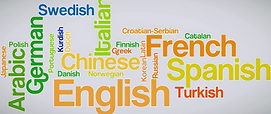
A Multilingual English Literacy Program
For Scholars Ages 5 to 105

TRWRR
Ludwig van Beethoven, 1770-1827
Karl Böhm- Vienna Philharmonic Orchestra
The Pastoral Symphony, aka No. 6
In F Major, Opus 68
First movement
Second movement
Third movement
Fourth movement
Fifth movement

Designed for Each Student to Progress According to His or Her Efforts and God-given Ability!
The Red Well-Read Reader
TRWRR is Totally Literate's flagship product. It consists of 361 humorous, pithy stories. Generally, each one has a single predominate rhyme.
The book starts off with stories having the short "a" sound. To illustrate, Story 1 has a preponderance of words ending with "ab," such as cab, lab, and nab. And Story 2 has a preponderance of words ending in "ack" or "ac," such as back, rack, and sacroiliac. There are twenty such groups in all. Systematically, they cover the entire phonological and phonemic makeup of the English language.
Besides stories, TRWRR Flipbook contains a list of spelling rules, and hundreds of phonics charts, many of which are illustrated with cartoon characters.
TRWRR is not merely a flipbook, but it's actually a reading course in and of itself, Although inaudible, it is decidedly sufficient to teach students to learn to read, let alone learn to become independent and critical thinkers. What's more, its low cost is practical for families on a tight budget. It is one of two products within our lowest priced Topaz Membership.
Introduction

Unique Features:
-
Appeals to everyone, to parents as much as to children.
-
Some stories, in part, challenge even the most precocious students.
-
On one hand, fast learners never get bored because the content is always challenging, whereas, on the other hand, slow learners never feel overwhelmed and quit trying to learn all-together because decoding remains constant throughout the book's entirety.
-
Each student benefits according to his or her effort, age, and God-given ability.

TRWRR
Various Forms:
-
The TRWRR Narrated Flipbook consists solely of TRWRR's rhyming stories with Spanish transcriptions shown side by side one another on opposite pages. This flipbook is accessible to Gold and Palladium members.
-
TRWRR is broken down into 9 Mini Flipbooks. In general, each book contains 40 stories. Each one has many links, providing a lot of fun navigating from story to story to Table of Contents. And the soothing classical music that plays between the narrated stories makes for an enjoyable experience.
-
TRWRR stories are also included as PDFs. They are included in a number of memberships.
-
Perhaps most helpful to students, especially foreign speakers, are TRWRR stories as Multilinguals. Multilinguals can be read aloud in scores of languages by Text-To-Speech "spokespersons" fluent in whichever language chosen, so to speak. What's more, every line of these stories is highlighted in one color and each word contrasted in another color as it is read aloud.
Each Form, Fun and Efficacious in its own right!
Adobe AI, Firefly, Partial Generative Summary
The document is an educational resource titled "Red Well-Read Reader," designed to teach reading comprehension and critical thinking skills to children and learners of all ages through engaging stories and phonics.
Dedication and Purpose of the Book
This book is dedicated to children who aspire to think independently and seek knowledge, aiming to empower them to hold government accountable and uphold their rights. It emphasizes the importance of critical thinking and comprehension over mere reading skills
-
Dedicated to children choosing independent thought over passive entertainment.
-
Encourages seeking knowledge and holding government accountable.
-
Aims to cultivate critical thinking and comprehension skills.
Acknowledgments and Learning Philosophy
The author acknowledges various contributors to the book and emphasizes the importance of reading as a means to develop character and understanding of the world. The book aims to teach students how to think critically rather than what to think.
-
Acknowledges friends, family, and contributors for support.
-
Highlights the importance of reading in character development.
-
Focuses on teaching critical thinking skills.
Comprehensive Learning Approach
The book combines phonics and the Look and Say methods to teach reading and comprehension, making learning engaging and fun. It serves as a vocabulary builder and is suitable for a wide range of learners, from young children to adults.
-
Combines phonics and Look and Say methods for effective learning.
-
Engaging stories make reading enjoyable and thought-provoking.
-
Suitable for learners of all ages, including adults in literacy programs.
Structure and Methodology of the Book
The book is structured to cover the phonetic structure of the English language through 361 stories, grouped by sound families. It employs a 5-Step Method to guide students through phonics, vocabulary, and comprehension.
-
Contains 361 stories grouped by phonetic sound families.
-
Employs a 5-Step Method for structured learning.
-
Focuses on phonics, vocabulary, and comprehension development.
Usage and Implementation Guidelines
The book should be used alongside other literature and includes specific steps for teaching reading and comprehension. It encourages concurrent teaching of printing and penmanship to reinforce learning.
-
Should be used with a variety of literature for comprehensive learning.
-
Printing and penmanship should be taught alongside reading.
-
Provides a structured approach to teaching reading skills.
Expected Outcomes and Benefits
The book aims to foster a lifelong love for learning and an appreciation for the English language, equipping students with the skills to navigate complex societal issues. It hopes to inspire students to become principled leaders.
-
Aims to develop a lifelong quest for knowledge.
-
Encourages appreciation of the English language.
-
Hopes to inspire students to become principled leaders.
Humorous Stories with Wordplay
The text features a collection of humorous stories that utilize clever wordplay and rhymes. Each story presents a unique character or situation, often leading to amusing conclusions. [Examples: first ten stories.]
-
Nabbed: Dr. McNabb tries to avoid sweets while dining but ends up being nabbed by the police for attempting to skip his bill.
-
The Wacky Hack: Jack, a cab driver, leads a chaotic life filled with mishaps and poor choices, ultimately living in a shack.
-
Tact: The importance of tact is highlighted, emphasizing thoughtful actions and positive impacts on others.
-
Brad: A lazy boy named Brad fails to make his parents proud and ends up regretting his choices in life.
-
Madge: Madge is arrested for begging, humorously arguing with the officer about her situation.
-
A Hearty Horse Laugh: A zebra complains about unfair treatment at the zoo, leading to a humorous exchange with the staff.
-
Daft: A playful dialogue between Bill and Sue showcases their misunderstanding and light-hearted banter.
-
The "Nag" and The "Scalawag": A young man named Wag faces nagging from his wife, leading to a comical argument about their marriage.
-
The Exam: Pam and Sam prepare for an exam in Amsterdam, humorously detailing their travel and snacks.
-
The Little Tramp: A camping trip takes a turn when Judy and Sue encounter a bear, leading to a humorous resolution.
Additional Rhyme Families
-
The text also includes various other rhyme families with unique sounds and structures.
-
Each family showcases the richness of the English language through phonetic similarities.
Phonetic Patterns and Similar Sounds
The text presents various phonetic patterns and similar sounds in the English language, categorized into charts. These charts illustrate how different consonants and vowel combinations produce similar sounds across various words.
-
Chart 2A and 2B detail initial consonants and their corresponding words, highlighting sounds like "c" in "celery" and "s" in "seal."
-
Chart 3A, 3B, and 3C further categorize consonant blends and similar sounds, showcasing examples like "sh" in "shark" and "th" in "thumb."
-
The charts emphasize the importance of recognizing phonetic similarities for better pronunciation and spelling.
Spelling Rules and Exceptions
The text outlines essential spelling rules and their exceptions in the English language, providing guidance for proper word formation.
-
Rule 1 states that single-syllable words ending in one consonant preceded by one vowel double the last letter (e.g., "run" becomes "running").
-
Rule 2 indicates that words ending in one consonant preceded by two vowels do not double the last letter (e.g., "sail" becomes "sailor").
-
Several exceptions are noted, such as words ending in "y" changing to "i" when preceded by a consonant (e.g., "beauty" to "beautiful").
-
The text also covers rules for pluralization, including how to handle nouns ending in "o" and compound nouns.
Consonants and Consonant Blends Overview
The text provides a comprehensive overview of consonants and consonant blends, showcasing their usage in various words.
-
Consonants like "b," "d," "l," and "m" are exemplified with words such as "box," "dog," "lion," and "man."
-
Consonant blends are categorized, including "bl" in "blow," "fr" in "frog," and "sp" in "spill."
-
The text emphasizes the significance of understanding consonant sounds for effective communication and literacy development.